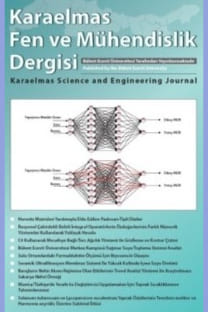Kahramanmaraş Topraklarından İzole Edilen Bacillus sp. Tarafından Alfa-Amilaz Üretimi ve Karakterizasyonu
Bacillus sp. A-3 Kahramanmaraş topraklarından izole edilmiştir. Suş 5.0-7.0 pH aralığında enzim sentezini gerçekleştirirken, maksimum amilolitik aktivite 37oC sıcaklık ve 6.5 pH değerinde gözlenmiştir. SDS-PAGE analizinde enzime ait 53.94 kDa ağırlığında tek bant elde edilmiştir. Enzimin optimum pH’sı 6.0-6.5 olarak belirlenmiştir. Enzimin maksimum rölatif aktivite gösterdiği sıcaklık değeri 35oC olup ve 25 ile 65oC arasında ortalama %68 bir rölatif aktiviteye sahiptir. Enzim 40oC ye kadar termostabil bir özellik sergilemiştir. Kimyasalların etkisi açısından ise en yüksek kalan aktivite %93 ile KCl ve en düşük ise %0.8 ile EDTA’da gözlenmiştir. Bu özellikleri ile A-3 alfa amilazı unlu mamul sanayiinde, biyoetanol üretiminde ve hurda kâğıt endüstrisinde önemli bir yer teşkil edebilecek potansiyeldedir
Anahtar Kelimeler:
Alfa amilaz, Bacillus, Karakterizasyon, Mezofilik, Saflaştırma, Stabilite
Production and Characterization of Alfa-Amylase by Bacillus sp. Isolated from Kahramanmaraş Soils
Bacillus sp. A-3 isolated from soils of Kahramanmaras. The maximum amylolitic activity was obtained at 37o C and pH 6.5 as the strain showed enzyme synthesis in between pH 5.0-7.0. SDS-PAGE analysis of the enzyme showed a single band which was estimated as 53.94 kDa. Optimum pH of the enzyme was determined as 6.0-6.5. Maximum relative activity of the enzyme presented was 35o C and also average 68% of relative activity was observed in between 25-65o C. Enzyme revealed a thermostable properties up to 40o C. In terms of chemicals effect, The highest remaining activity was 93% with KCl as the lowest one was 0.8% in the presence of EDTA. According to these properties of the A-3 alpha amylase has potential to have an important place in baking, bioethanol production and waste paper industries
Keywords:
Bacillus, alfa amilaz, karakterizasyon, mesofilik, saflaştırma, stabilite,
___
- Aygan, A., Arikan, B., Korkmaz, H., Dincer, S., Colak, O. 2008. Highly thermostable and alkaline alpha amylase from Halotolerant- alkaliphilic Bacillus sp. AB68. Braz. J. Microbiol., 39: 547-553.
- Bachmeier, K., Williams, A.E., Warmington, J., Bang, S.S. 2002. Urease Activity in Microbiologically-Induced Calcite Precipitation. J. Biotechnol., 93: 171-181.
- Beg, Q.K., Kapoor, M., Mahajan, L., Hoondal, G.S. 2001. Microbial xylanases and their industrial applications: a review. Appl Microbiol Biotechnol., 56: 326- 338.
- Bernhardsdotter, ECMJ., Ng, JD., Garriott, OK., Pusey, ML. 2005. Enzymic properties of an alkaline chelator-resistant α amylase from alkaliphilic Bacillus sp. isolate L1711. Process Biochem., 40: 2401-2408.
- Coronado, MJ., Vargas, C., Hofemeister, J., Ventosa, A., Nieto, J.J. 2000. Production and biochemical characterization of an α-amylase from the moderate halophile Halomonas meridiana. FEMS Microbiol., Lett., 183: 67-71.
- Das, K., Doley, R., Mukherjee, AK. 2004. Purification and biochemical characterization of a thermostable, alkaliphilic, extracellular a-amylase from Bacillus subtilis DM-03, a strain isolated from the tradition fermented food of India. Biotechnol. Appl. Biochem. 40: 291-298.
- Demirkan, E.S., Bunzo, M., Adachi, M., Higasa, T. Utsumi, S. 2005. α-Amylase from B. amyloliqefaciens: purification, characterization, raw starch degradation and expression in E. coli. Process Biochem., 40:2529-2636.
- Godfrey, T., West, S. 1996. Introduction to Industrial Enzymology. (T.Godfrey and S. West editör) Industrial Enzymology,2nd Edition, Stockton Pres, New York.
- Ozcan, BD., Baylan, M., Ozcan, N., Tekdal, D. 2010. Characterization of thermostable α -amylase from thermophilic and alkaliphilic Bacillus sp. isolate DM-15. Res. J. Biol. Sci., 5: 118-124.
- Rao, MB., Tanksale, AM., Gathe, MS., Deshpande, VV. 1998. Molecular and biotechnological aspects of microbial proteases. Microbiol. Mol. Biol. Rev., 62: 597-635.
- Ratanakhanokchai, K., Kyu, KL., Tanticharoen, M. 1999. Purification and properties of a xylan-binding endoxylanase from alkaliphilic Bacillus sp. strain K-1. Appl Environ Microbiol., 65: 694-697.
- Reddy, NS., Nimmagadda, A., Sambasiva Rao, KRS. 2003. An overview of the microbial α-amylase family. Afr. J. Biotechnol., 2: 645-648.
- Saul, DJ., Williams, LC., Grayling, RA., Chamley, LW., Love, DR., Bergquist, PL. 1990. celB, A gene coding for a bifunctional cellulase from the extreme thermophile “Caldocellum saccharolyticum”. Appl. Environ. Microbiol., 56: 3117–24.
- Schallmey, M., Singh., A., Waerd, OP., 2004. Developments in the Use Of Bacillus Species for Industrial Production. Can. J. Microbiol., 50:1-17.
- Sharma, A., Satyanarayana, T. 2010. High maltose-forming, Ca2+-independent and acid stable a-amylase from a novel acidophilic bacterium, Bacillus acidicola. Biotechnol. Lett., 32: 1503–1507.
- Shibuya, I., Iimura, Y., Ishikawa, T., Oucki, K., Matsuyama, A., Yamamoto, T., 1986. Isolation and Characterization of Starch Utilizing Mutants of Escherichia coli. Agric.Biol.Chem., 50: 875- 882.
- Sivaramakrishan, S., Gangadharan, D., Nampoothiri, KM., Sccol, CR., Pandey, A. 2006. α-Amylases from Microbial sources-An Overview on Recent Developments. Food Technol Biotechnol., 44: 173-184.
- Syu, MJ., Chen, YH. 1997. A study on the α-amylase fermentation performed by Bacillus amyloliquefaciens. Chem. Eng. J., 65: 237- 247.
- Vidyalakshmi, R., Paranthaman R., Indhumathi, J. 2009. Amylase Production on Submerged Fermentation by Bacillus spp.World J. Chem., 4 (1): 89-91.
- Vihinen, M., Mantsala, P., 1990. Characterization of a Thermostable Bacillus stearothermophilus - α-Amylase. Biotechnol. Appl. Biochem., 12: 427-435.
- Wind, RD., Buitelaar, RM., Eggink, G., Huizing, HJ., Dykhulzen, L., 1994. Characterization of a New Bacillus stearothermophilus Isolate : A Highly Thermostable α- Amylase Producing Strain. Appl. Microbiol. Biotechnol., 41: 155-162
- ISSN: 2146-4987
- Yayın Aralığı: Yılda 2 Sayı
- Başlangıç: 2011
- Yayıncı: ZONGULDAK BÜLENT ECEVİT ÜNİVERSİTESİ
